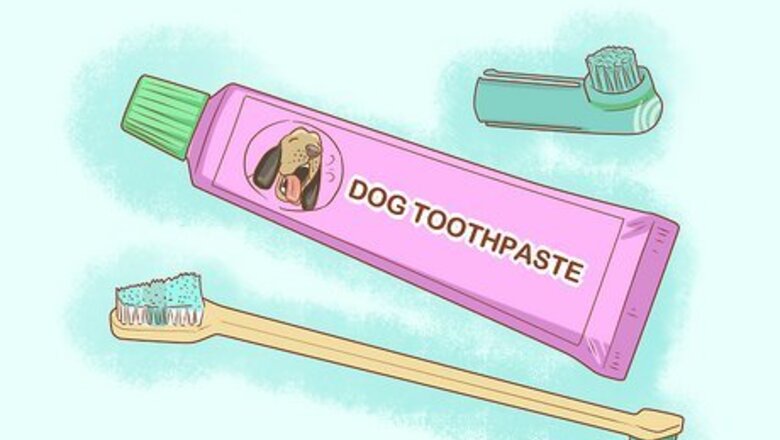
views
Polish your dog’s teeth with a soft-bristled toothbrush.
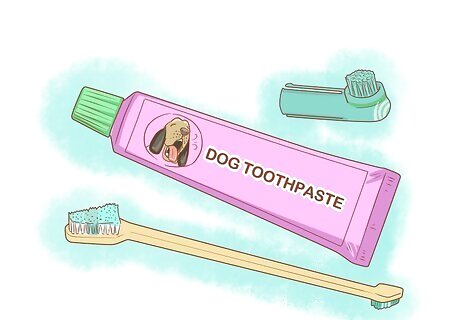
Put enzymatic toothpaste on it and clean each and every tooth. When your dog is relaxed—such as when it’s laying down—crouch down to your dog’s eye level. Then, squeeze a dab of enzymatic toothpaste onto the toothbrush. Place the brush flat on your dog’s teeth and polish each tooth individually. Use an enzymatic toothpaste specially formulated for dogs. Some enzymatic toothpastes, like Virbac, contain flavors like vanilla, which many dogs love. These toothpastes will also fresh your dog’s breath!
Give your dog dental chews to remove tartar buildup.
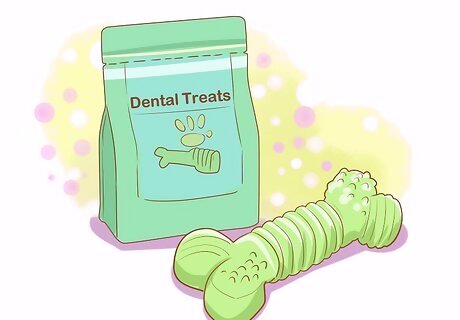
When your dog chews on dental treats, plaque and tartar get broken up. Choose from dental rawhide, sticks, bones, or biscuits. Check the label to make sure that the chew is best for your dog’s size. Provide your dog up to one dental chew a day. Be sure to supervise your dog while it gnaws on its dental treat. Once the dental chew breaks apart, throw it away so it won’t splinter and harm your dog’s gums or teeth. When your dog gnaws on either a dental treat or toy, it scrapes off the plaque and tartar on its teeth. All-natural dental treats have enzymes that promote dental health, and many dental treats contain ingredients that freshen your dog’s breath. Limit your dog to one dental treat a day so your pet can maintain a healthy weight. Give your dog a dental chew toy in place of a treat if your pet is on a vet-recommended diet. Your dog will still have a great time!
Clean your dog’s teeth with dental wipes.
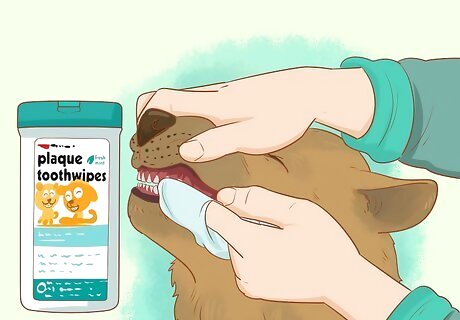
Dental wipes remove any calcium that can harden into plaque or tartar. Crouch down by your dog, talk in an upbeat voice, and place your finger on one of its teeth. If your dog is calm and relaxed, then gently touch its teeth with a dental wipe. Once your dog adjusts to the dental wipe, use it to rub each tooth in a circular motion. After you place a dental wipe against your dog's teeth to let it adjust to the new object, give your pet lots of praise. Since dental wipes break down calcium, they also soften tartar, which is actually made up of calcium deposits that cling onto your dog’s teeth and lead to health problems like gingivitis. Dental wipes like Petkin Fresh Mint wipes contain baking soda, so they’ll remove stains on your dog’s teeth and freshen your pet’s breath.
Rub oral care gel on your dog’s mouth.
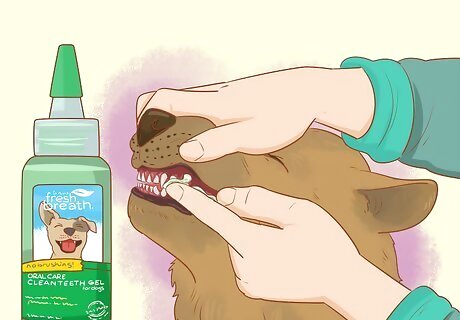
This specially formulated gel removes plaque and tartar. Pet your dog and lightly touch the inside of its mouth. Once your dog adjusts to this, squeeze two drops of oral care gel onto your index finger and dab the right side of your dog’s mouth. Repeat this step on the left side of your dog’s mouth. Apply oral care gel daily and you should see results in 30 days or less. You won’t need to brush your dog’s teeth if you use oral care gels like TropiClean Fresh Breath. Your dog’s saliva mixes with the oral care gel and activates ingredients that break down plaque and tartar. Oral care gel will also fight bacteria and freshen your dog’s breath.
Use dental spray to break down plaque on your dog’s teeth.
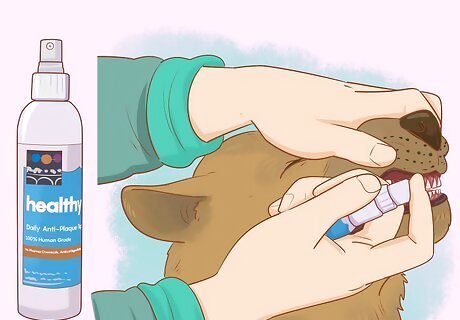
Dental spray removes plaque before it hardens into tartar. Pet your dog to calm it down, then spritz your dog’s gums and teeth with your dental spray. Your dog’s saliva will mix with the dental spray to create a film that dissolves the plaque and calcium in tartar. Read the label on your dental spray and check the dose for your dog’s size. Use dental spray 30 minutes before or after your dog eats. You may need to use dental spray more often if your dog has advanced tartar buildup on its teeth. A dental spray like HealthyMouth doesn’t have alcohol or toxins and uses natural ingredients to significantly reduce tartar and prevent gum disease. For maximum results, combine dental spray with daily brushing. If your dog moves around a lot and you can’t spritz its mouth with dental spray, apply the dental spray to its dog toys. When they chew on the dog toys, the dental spray will get into its mouth.
Let your dog chew on bones to break up tartar.
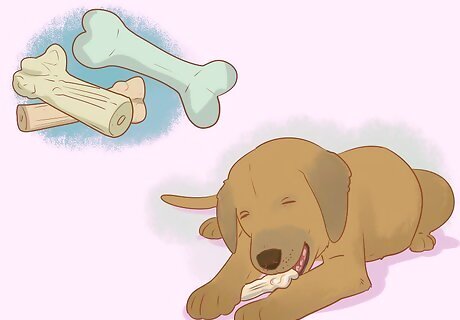
Bones help knock off tartar when dogs gnaw on them. Choose a bone that’s the right size for your pet—it shouldn’t be small enough to swallow or so big that your dog can’t chew on it. Supervise your dog while it nibbles on its bone. Once your dog can fit an entire bone into its mouth. Raw bones are great options for fighting tartar because they don’t splinter, so they won’t damage your dog’s teeth. Use the “knee cap” test to check if bones are soft enough for your dog—if you hit your knee cap with a bone and it hurts, then it’s too hard for your dog to chew on. If your dog chews on a bone aggressively, take it away so you can prevent your pet from fracturing its teeth.
Reward your dog with a treat after cleaning its teeth.
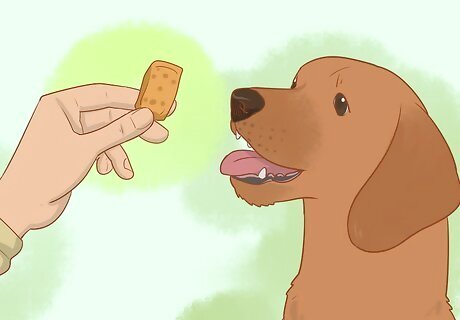
Your dog is more likely to look forward to oral care routines. Once you’ve finished with your preferred method to fight tartar, reward your dog with a treat for being so cooperative. Then, praise and pet your dog so it associates teeth cleaning with fun. Use an upbeat, energetic tone of voice to motivate your dog. Your pet will feel more excited about teeth cleaning. Give your dog the same compliments you provide as a reward for any good behavior. For example, you can say, “Good boy!” The recommended maximum amount of treats you should give your dog is about 10% of its daily calories.
Use coconut oil to prevent tartar buildup on your dog’s teeth.
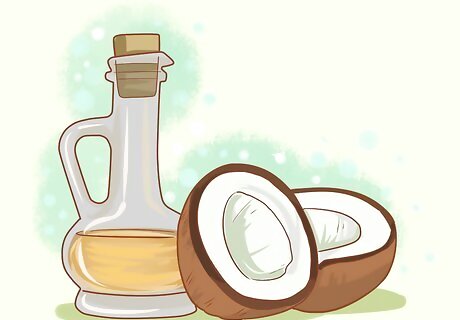
Fight plaque and tartar with the antibacterial properties of coconut oil. Put 1 tbsp (14 mL) of coconut oil on a soft-bristled “doggy toothbrush.” Brush your dog’s teeth in a circular motion for about 2 minutes. When you’re finished, pet and praise your dog. For best results, brush your dog’s teeth with coconut oil once a day. To save yourself a lot of effort, avoid giving your dog a treat because you might have a harder time cleaning its teeth. Play a game, like fetch, so your dog gets excited for getting its teeth brushed. First, check with your vet to make sure coconut oil can be introduced to your dog’s diet—if your dog needs to lose weight, coconut oil may not be the best method for your pet. Add coconut oil to your dog’s food for added tartar prevention. Jessica Vogelsang Jessica Vogelsang, Veterinarian To help soften stubborn tartar on your dog's teeth before brushing, mix equal parts coconut oil and water into a thin, spreadable paste. Gently rub this homemade solution along the gumlines and over surface deposits for 2-3 minutes before brushing as usual. The coconut oil helps loosen plaque so more comes off during regular brushing.
Spritz your dog’s teeth with an oral rinse to keep its teeth clean.
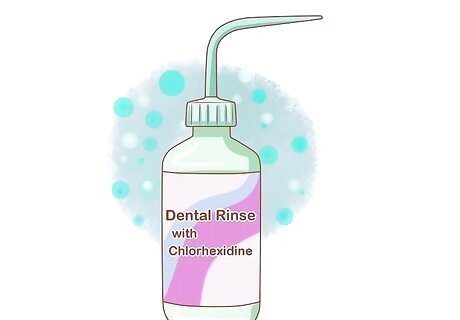
The main ingredient in oral rinses, chlorhexidine, kills bacteria and prevents tartar. Pull up your dog’s lip and squirt one drop of the oral rinse inside each of your pet’s cheeks. Your dog’s saliva mixes with the oral rinse and coats both its teeth and its gums to prevent plaque and tartar buildup. Most chlorhexidine oral rinses are flavored, your dog will probably like it when you use them. Since it fights bacteria, an oral rinse will also freshen your dog’s breath. Oral rinses are specially formulated to be antimicrobial, anti-plaque, and anti-calculus, so they’ll protect your dog from tooth and gum disease. Play with your dog and give it lots of affection after you apply the oral rinse!
Pour a dental additive into your dog’s water to reduce tartar buildup.
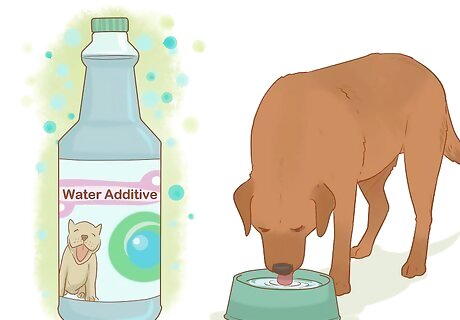
A dental additive keeps the water fresh and free of bacteria that causes tartar. First, ask your vet if they recommend daily water additives. If your vet advises dental additives, read the label of your dental additive and pour the suggested amount into your dog’s water bowl. When your dog drinks water, the dental additive acts as a mouthwash and cleans its gums and teeth. Many dental additives are odorless, so your dog won’t even notice anything different about its water. Clean your dog’s water bowl after each use to make sure it’s sterilized. Since a dental additive kills bacteria, it will prevent both tartar and mouth infections. Your vet will let you know if your dog has pre-existing conditions or is on medications that water additives can interfere with.
Bring your dog to the vet once a year for a regular teeth cleaning.
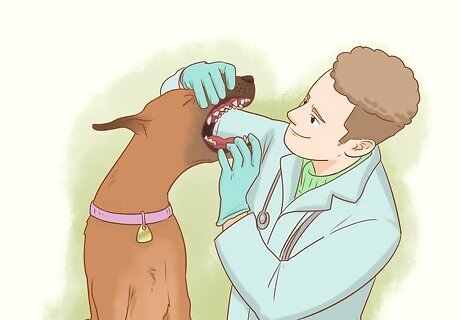
Most vets recommend a yearly professional cleaning to fight tartar buildup. If your dog already shows signs of thick tartar buildup, then schedule an appointment with your vet. Your vet will give your dog a thorough cleaning under anesthesia to remove all the tartar. Dogs need regular dental visits to maintain their oral health, just like humans! If your dog develops lots of tartar really quickly, you might need to bring it to the vet every 6 months. If your dog has routine teeth cleanings at the vet, it'll be easier for you to use home methods that reduce your dog’s tartar.



















Comments
0 comment